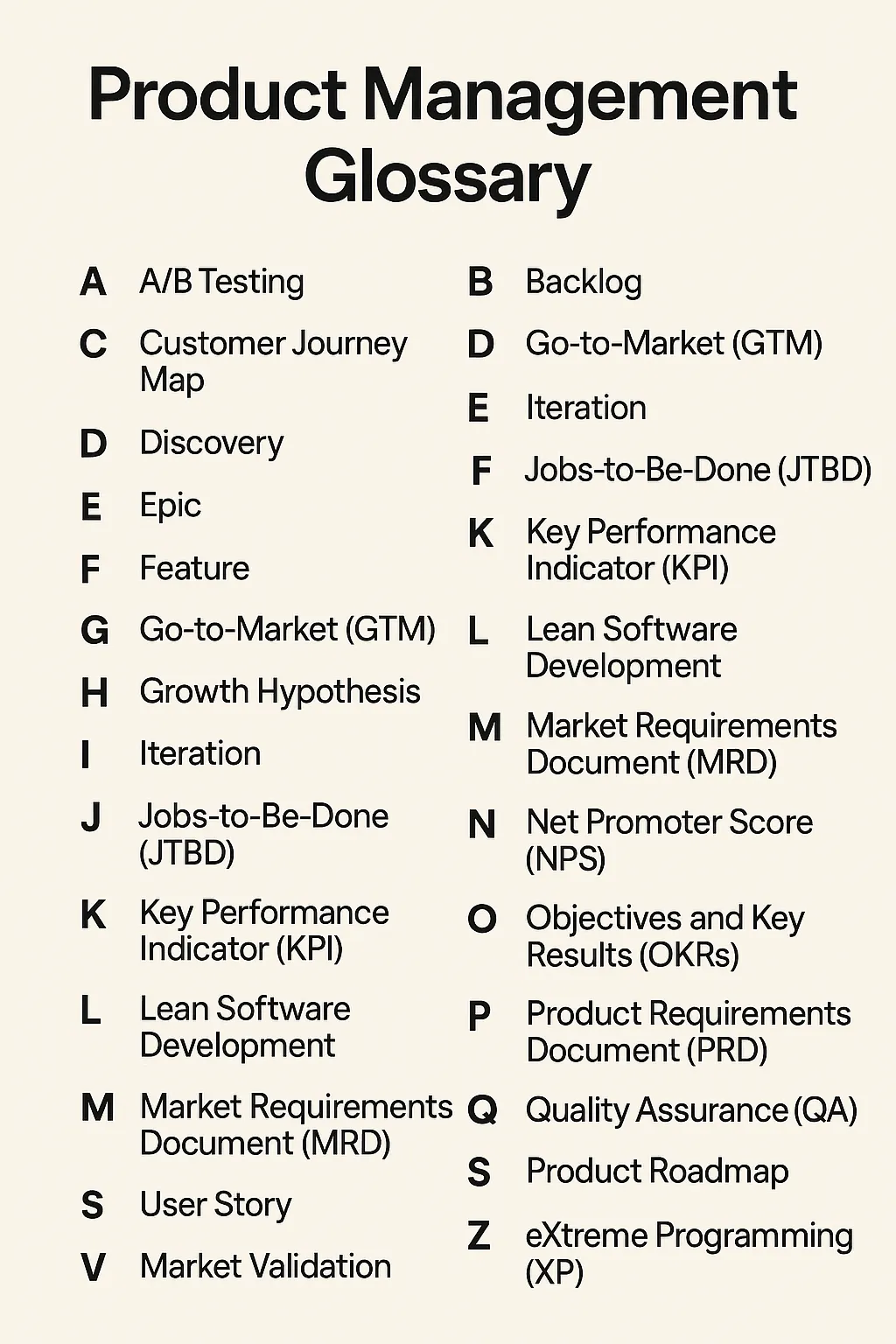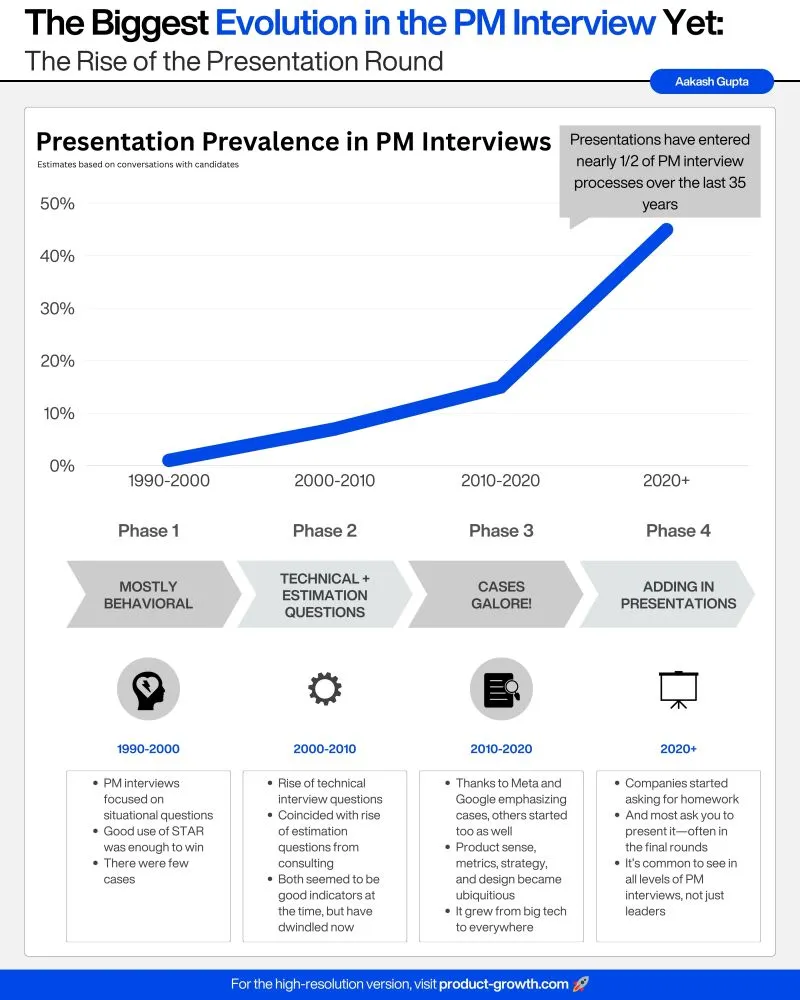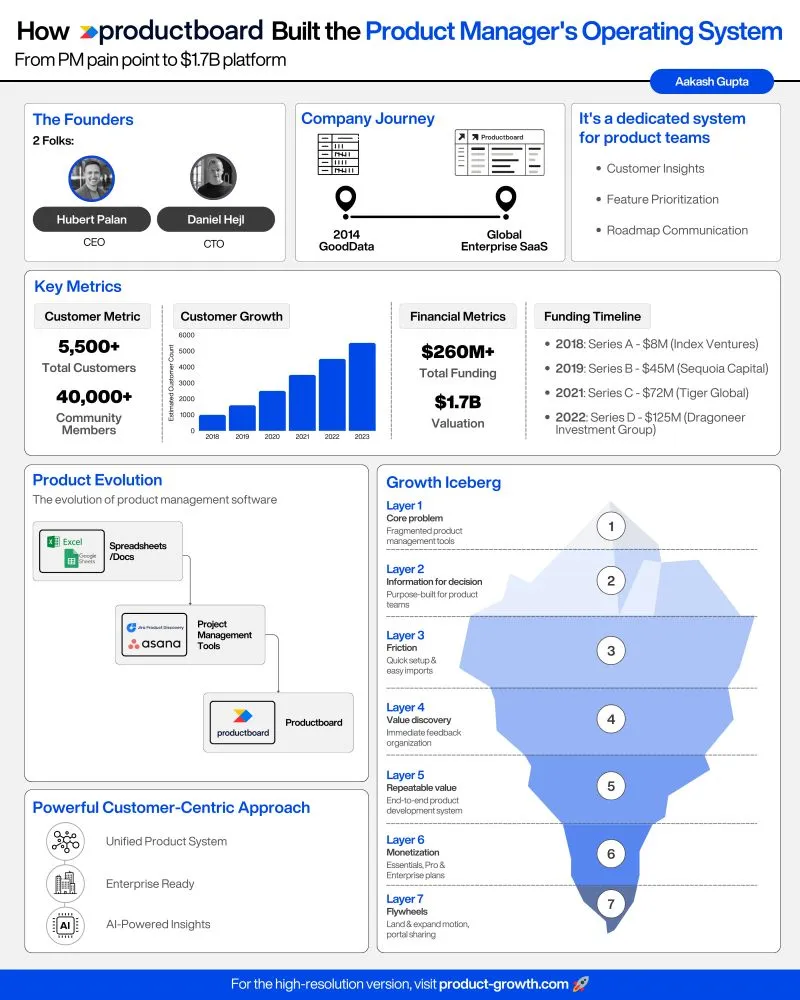
Product Management Glossary: A to Z Terms Every Product Manager Should Know
As a product manager, understanding the terminology that shapes our field is crucial for effective communication, strategic planning, and successful product delivery. Below is a comprehensive glossary of product management terms from A to Z, covering everything from foundational concepts to advanced methodologies. Whether you’re new to the role or a seasoned pro, this guide will serve as a handy reference.
A
- A/B Testing: A method of comparing two versions of a product or feature to determine which performs better based on user behavior or metrics.
- Accessibility: Designing products to be usable by people with disabilities, ensuring inclusivity and compliance with standards.
- Agile Methodology: A flexible, iterative approach to product development that emphasizes collaboration, adaptability, and customer feedback.
- Algorithm: A set of rules or instructions used in software to solve problems or perform tasks.
- API (Application Programming Interface): A set of rules allowing different software applications to communicate with each other.
- Artificial Intelligence (AI): The simulation of human intelligence in machines, often used to enhance product functionality.
- Augmented Reality (AR): A technology that overlays digital information onto the real world, enhancing user experiences.
B
- Backlog: A prioritized list of tasks, features, or bugs to be addressed in a product development cycle.
- Beta Testing: A phase where a product is tested by a limited group of users before its full release to identify issues.
- Big Data: Large, complex data sets analyzed to reveal patterns, trends, and insights for product decisions.
- Blockchain: A decentralized, secure digital ledger technology often used for transparency and trust in products.
- Bounce Rate: The percentage of users who leave a website after viewing only one page, indicating engagement levels.
- Brainstorming: A group creativity technique for generating ideas to solve problems or innovate.
- Branding: The process of creating a unique identity for a product or company to differentiate it in the market.
- Break-Even Point: The point at which total revenue equals total costs, indicating no profit or loss.
- Build-Measure-Learn: A feedback loop in the Lean Startup methodology to iterate quickly based on validated learning.
- Business Intelligence (BI): Tools and practices for collecting and analyzing data to inform business decisions.
C
- Cannibalization: When a new product reduces sales of an existing product within the same portfolio.
- Carbon Neutrality: Achieving a balance between carbon emissions and absorption, often a sustainability goal.
- Channel: The path through which products reach customers, such as retail or online platforms.
- Churn Rate: The percentage of customers who stop using a product over a given period.
- Click-Through Rate (CTR): The percentage of users who click on a link, often used in email or ad campaigns.
- Commercialization: The process of bringing a new product or service to market.
- Communication: The ability to convey information clearly, a key skill for product managers.
- Competitive Analysis: Evaluating competitors’ strengths and weaknesses to inform product strategy.
- Compliance: Adhering to laws, regulations, and standards relevant to a product.
- Computer Vision: AI technology enabling computers to interpret visual information, used in innovative products.
- Content Marketing: Creating valuable content to attract and engage a target audience.
- Conversion Rate: The percentage of users who complete a desired action, such as making a purchase.
- Corporate Social Responsibility (CSR): A company’s commitment to ethical and sustainable practices.
- Cost-Benefit Analysis: Comparing the costs and benefits of a decision to assess its viability.
- Cross-Functional Team: A team with members from different departments collaborating on a product.
- Crowdsourcing: Gathering ideas or solutions from a large group, often users or the public.
- Cryptocurrency: A digital currency secured by cryptography, often built on blockchain.
- Customer Acquisition Cost (CAC): The cost of acquiring a new customer, a key financial metric.
- Customer Experience (CX): The overall perception a customer has of a brand based on interactions.
- Customer Journey: The complete set of experiences a customer has with a product or brand.
- Customer Lifetime Value (CLV): The total revenue expected from a customer over their lifetime.
- Customer Relationship Management (CRM): Strategies and tools to manage customer interactions.
- Customer Satisfaction (CSAT): A measure of how well a product meets customer expectations.
- Customer Service: Support provided to customers before, during, and after a purchase.
D
- Data Analytics: Examining data to draw conclusions and inform product decisions.
- Data Privacy: Protecting personal information collected from users, often a legal requirement.
- Data-Driven Decision Making: Using data to guide product strategy and decisions.
- Decentralized Finance (DeFi): Financial services built on blockchain, disrupting traditional models.
- Defect: A flaw or imperfection in a product that impacts quality or functionality.
- Design Thinking: A problem-solving approach emphasizing empathy, ideation, and experimentation.
- DevOps: Practices combining development and operations to shorten the product lifecycle.
- Digital Health: Using technology to improve health and healthcare delivery.
- Digital Transformation: Integrating digital technology into all areas of a business or product.
- Digital Twin: A virtual representation of a physical object or system, used for testing and analysis.
- Digital Wallet: Software or devices enabling electronic transactions, common in fintech.
- Disruptive Innovation: An innovation that significantly alters a market or industry.
- Distribution: The process of delivering products to customers through various channels.
- Drop Shipping: A retail method where the seller transfers orders to a third party without stocking products.
- Dynamic Pricing: Adjusting prices in real-time based on demand, competition, or other factors.
E
- E-Commerce: Buying and selling goods or services over the internet.
- Early Access: Providing select customers with pre-release access to a product for feedback.
- Early Adopter: A customer who uses a new product before it gains widespread adoption.
- E-Learning: Learning conducted via electronic media, often used in edtech products.
- Edge Computing: Processing data near its source rather than centrally, enhancing IoT products.
- Emotional Intelligence: The ability to manage emotions, critical for leadership in product management.
- Empathy: Understanding users’ needs and feelings, a core principle in design thinking.
- End-of-Life (EOL): The point at which a product is no longer supported or sold.
- Engagement Rate: The level of user interaction with a product, often a key metric.
- Enterprise: A large, established company with complex product management needs.
- Ethical Design: Designing products with moral principles and user well-being in mind.
- Extended Reality (XR): An umbrella term for AR, VR, and MR technologies.
F
- Feature Bloat: Adding unnecessary features that complicate a product.
- Feedback Loop: A system for collecting and responding to customer feedback to improve a product.
- Fintech: Financial technology innovating in the financial sector.
- Focus Group: A group discussion with users to gather qualitative feedback.
- Front-end: The user-facing part of a software application.
G
- Gamification: Applying game-design elements to non-game contexts, like edtech or engagement.
- Gantt Chart: A visual representation of a project schedule, used in project management.
- GDPR (General Data Protection Regulation): An EU regulation on data protection and privacy.
- Gene Editing: Modifying DNA to achieve desired traits, relevant in biotech products.
- Globalization: Designing products for use across multiple markets without significant changes.
- Go-to-Market Strategy: A plan for launching and promoting a product to its target audience.
- Green Technology: Environmentally friendly technology, often tied to sustainability goals.
- Growth Hacking: Creative, low-cost strategies to acquire and retain customers rapidly.
H
- Health Informatics: Applying IT to healthcare, a key aspect of digital health products.
- Help Desk: A resource providing customer support and information.
- HIPAA (Health Insurance Portability and Accountability Act): A US law protecting health data privacy.
I
- Ideation: The process of generating and developing new ideas, often in design thinking.
- Impression: The number of times an ad or content is displayed, regardless of clicks.
- Influencer: A person with a large following who can impact user opinions, often in social media.
- Information Architecture: Organizing and structuring information within a product for usability.
- Innovation: Creating new ideas, products, or methods to solve problems or add value.
- Intellectual Property (IP): Legal rights protecting creations like patents and trademarks.
- Internationalization: Designing products to be easily adaptable to different regions and languages.
- Internet of Things (IoT): A network of connected devices exchanging data, enhancing smart products.
- Intrapreneurship: Entrepreneurship within an existing organization, often driving innovation.
- Inventory: The stock of products held by a company, critical in supply chain management.
- Inventory Turnover: The rate at which inventory is sold and replaced, a retail metric.
J
- Jobs to Be Done (JTBD): A framework for understanding customer needs and motivations.
- Just-In-Time (JIT): A manufacturing strategy minimizing inventory by producing goods as needed.
K
- Kanban: A visual system for managing work as it moves through a process, often used in agile.
- Key Performance Indicator (KPI): A measurable value tracking a product’s success.
- Keyword: A term users search for, critical in SEO and content marketing.
L
- Launch Campaign: Marketing activities to generate buzz for a product launch.
- Lead: A potential customer showing interest in a product or service.
- Lead Generation: Attracting and converting prospects into potential customers.
- Lean Manufacturing: A methodology eliminating waste in production processes.
- Lean Startup: A methodology emphasizing rapid iteration and customer feedback.
- Learning Management System (LMS): Software for delivering and managing educational courses.
- Legacy Product: An outdated product still in use but not actively developed.
- Licensing: Granting permission to use intellectual property for royalties.
- Lifetime Value (LTV): The total revenue a customer generates over their lifetime.
- Localization: Adapting a product to meet the language and cultural needs of a specific market.
- Logistics: Coordinating the movement of goods in the supply chain.
M
- Machine Learning: A subset of AI enabling systems to learn from data without explicit programming.
- Manufacturing: Producing goods on a large scale, often involving physical products.
- Market Analysis: Assessing a market’s attractiveness and dynamics.
- Market Fit: The degree to which a product satisfies its target market’s needs.
- Market Research: Gathering and analyzing data about a target market.
- Market Segmentation: Dividing a market into groups with similar needs or characteristics.
- Market Share: The percentage of a market controlled by a product or company.
- Merchandising: Presenting and promoting products in a retail setting.
- Meta Tag: HTML metadata improving a webpage’s SEO performance.
- Milestone: A significant event or achievement in a product’s development timeline.
- Minimum Viable Product (MVP): A basic product version released to test hypotheses with minimal resources.
- Mixed Reality (MR): A blend of physical and digital worlds, combining AR and VR.
- Moment of Truth: A critical interaction shaping a customer’s perception of a product.
- MoSCoW Method: A prioritization technique categorizing features as Must-have, Should-have, Could-have, or Won’t-have.
N
- Nanotechnology: Manipulating matter at the atomic scale, used in advanced products.
- Natural Language Processing (NLP): AI enabling computers to understand human language.
- Net Promoter Score (NPS): A metric measuring customer loyalty and satisfaction.
- Network Effect: When a product’s value increases as more people use it.
- Nano-sensors: Tiny sensors detecting changes at the nanoscale, used in tech products.
O
- Objectives and Key Results (OKRs): A framework for setting and tracking product goals.
- Omnichannel: A seamless shopping experience across multiple channels.
- Onboarding: Helping new customers get started with a product.
- Open Rate: The percentage of email recipients who open a campaign email.
P
- Patent: A legal right granting exclusive use of an invention.
- Pay-Per-Click (PPC): An advertising model where advertisers pay per ad click.
- Payment Gateway: A service processing online transaction payments.
- Personalization: Tailoring products or experiences to individual users.
- Pivot: A strategic shift in direction based on feedback or market changes.
- Podcast: Digital audio content, often used in content marketing.
- Point of Sale (POS): The location where a transaction occurs, typically in retail.
- Portfolio Management: Managing a mix of products to achieve strategic goals.
- Positioning: How a product is perceived in the market relative to competitors.
- Predictive Analytics: Using data to forecast trends and behaviors.
- Pricing Strategy: The method for setting product prices, e.g., value-based or cost-plus.
- Privacy by Design: Incorporating privacy into product design from the start.
- Product Designer: The person designing a product’s user experience and interface.
- Product Launch: Introducing a new product to the market.
- Product Lifecycle: The stages a product goes through from conception to retirement.
- Product Line: A group of related products under a single brand.
- Product Manager: The person defining a product’s vision and strategy.
- Product Owner: The person responsible for defining and prioritizing the product backlog in Scrum.
- Product Portfolio: The collection of products offered by a company.
- Product Requirements Document (PRD): A detailed document outlining product requirements.
- Product Strategy: The plan to achieve a product’s goals and objectives.
- Product Vision: A long-term goal defining a product’s purpose and direction.
- Prototype: A working model of a product used for testing and feedback.
Q
- Quality Assurance: Processes ensuring a product meets quality standards.
- Quality Control: Activities monitoring and maintaining quality during production.
- Quantum Computing: Advanced computing using quantum bits for complex problem-solving.
- Quota: A sales target a salesperson is expected to meet.
R
- Rapid Prototyping: Quickly creating prototypes, often with 3D printing.
- Recommendation Engine: A system suggesting products based on user behavior.
- Recall: Retrieving and replacing defective products from the market.
- Retention Rate: The percentage of customers continuing to use a product over time.
- Retailer: A company selling products directly to consumers.
- Return on Investment (ROI): A measure of investment profitability.
- RICE Scoring: A prioritization method based on Reach, Impact, Confidence, and Effort.
- Risk Management: Identifying, assessing, and mitigating risks in product development.
- Roadmap: A strategic plan outlining a product’s vision, direction, and progress.
- Robotics: Designing and using robots, often integrated with AI.
S
- Sales Funnel: The customer journey from awareness to purchase.
- Sales Pipeline: A visual representation of the sales process.
- Scalability: A system’s ability to handle increased load without performance loss.
- Scope Creep: Uncontrolled expansion of a project’s scope.
- Scrum: An agile framework for managing product development.
- Scrum Master: A facilitator helping a team follow the Scrum framework.
- Search Engine Optimization (SEO): Improving a website’s visibility in search results.
- Segmentation: Dividing customers into groups based on shared traits.
- Self-Driving Car: An autonomous vehicle navigating without human intervention.
- Service Design: Designing services to meet customer needs effectively.
- Shopping Cart: A virtual cart holding items for purchase in e-commerce.
- Six Sigma: A methodology reducing defects to improve quality.
- Smart City: A city using technology to enhance residents’ quality of life.
- Smart Contract: A self-executing contract on blockchain with coded terms.
- Smart Devices: Internet-connected devices, integral to IoT.
- Social Media: Platforms for creating and sharing content, key in marketing.
- Sprint: A time-boxed period in agile for completing specific work.
- Stakeholder: Anyone with an interest in a product’s success.
- Story Mapping: Visualizing the user journey to prioritize features.
- Sunsetting: Gradually phasing out a product.
- Supply Chain: The network delivering goods from suppliers to customers.
- Sustainability: Designing products to minimize environmental impact.
- SWOT Analysis: A framework analyzing strengths, weaknesses, opportunities, and threats.
- Synthetic Biology: Designing new biological systems, relevant in biotech.
T
- Target Market: The specific customer group a product aims to serve.
- Targeting: Directing marketing efforts to specific customer segments.
- Technical Debt: The cost of rework from choosing quick solutions over optimal ones.
- Telemedicine: Remote medical care using telecommunications, part of digital health.
- Terms of Service: A legal agreement between a provider and users.
- Tier: A level in a loyalty program offering different benefits.
- Total Quality Management (TQM): An approach emphasizing continuous quality improvement.
- Touchpoint: Any interaction point between a customer and a brand.
- Trademark: A symbol or phrase distinguishing a product legally.
- Training Data: Data used to teach machine learning models.
U
- Unified Commerce: A single platform integrating all sales channels.
- Usability: The ease of use and learnability of a product.
- Usability Testing: Observing users to identify usability issues.
- User Experience (UX): The overall experience a user has with a product.
- User Flow: A diagram showing a user’s path through a product.
- User Interface (UI): The visual elements users interact with in a product.
- User Persona: A fictional representation of an ideal customer.
- User Research: Understanding user needs, behaviors, and motivations.
- User Story: A feature description from the end user’s perspective.
- User-Generated Content: Content created by users, enhancing engagement.
V
- Validated Learning: Testing hypotheses to learn from results, a Lean Startup principle.
- Value Proposition: The unique value a product offers its customers.
- Vehicle-to-Everything (V2X): Communication between a vehicle and other entities.
- Vendor: A supplier of goods or services in the supply chain.
- Viral Marketing: Encouraging users to share a message rapidly.
- Virality: A product’s tendency to spread quickly among users.
- Virtual Reality (VR): A simulated environment immersing users, often for entertainment or training.
W
- Waterfall Model: A linear project management approach completing phases sequentially.
- Wearable Devices: Body-worn devices collecting data, common in digital health.
- Webinar: An online seminar, often used in content marketing.
- Wholesaler: A company buying in bulk and selling to retailers.
- Wireframe: A low-fidelity sketch of a product’s layout.
X
- Extended Reality (XR): Encompassing AR, VR, and MR for immersive experiences.
- eXtreme Programming (XP): XP is an agile framework emphasizing short development cycles, continuous feedback, and engineering practices like pair programming and test‑driven development to improve software quality.
Y
- Year‑Over‑Year (YoY) : Year‑over‑year compares performance metrics for one period (e.g., quarter) against the same period in the previous year to identify growth trends while accounting for seasonality.
Z
- Zero‑Based Budgeting (ZBB) Zero‑based budgeting is a planning method where every expense must be justified from a “zero base” each cycle, ensuring alignment with current priorities and eliminating automatic incremental increases.









Comments ...
No Comments Yet ...Add One